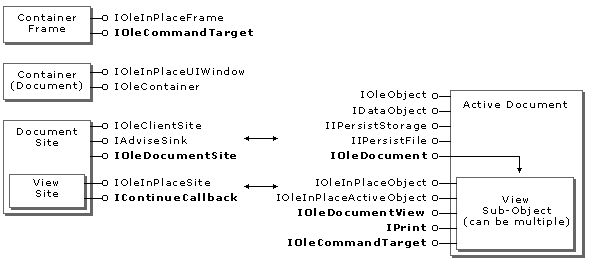
An active document container allows you to work with several documents of different application types within a single frame (instead of forcing you to create and use multiple application frames for each document type).
MFC provides full support for Active document containers in the COleDocObjectItem class. You can use the MFC AppWizard to create an Active document container by selecting the Active document container checkbox in step 3 of the MFC AppWizard. See Creating an Active Document Container Application for more information.
Active document support in an Active document container implies more than just interface implementations: it also requires knowledge of using the interfaces of a contained object. The same applies to Active document extensions, where the container must also know how to use those extension interfaces on the Active documents themselves.
An active document container that integrates Active documents must:
The frame object, the view objects, and the container object can optionally implement IOleCommandTarget to support the dispatch of certain commands, as discussed in Command Targets. View and container objects can also optionally implement IPrint and IContinueCallback, to support programmatic printing, as discussed in Programmatic Printing.
The following figure shows the conceptual relationships between a container and its components (at left), and the Active document and its views (at right). The Active document manages storage and data, and the view displays or optionally prints that data. Interfaces in bold are those required for Active document participation; those bold and italic are optional. All other interfaces are required.

A document that supports only a single view can implement both the view and document components (that is, their corresponding interfaces) on a single concrete class. In addition, a container site that only supports one view at a time can combine the document site and the view site into a single concrete site class. The containerís frame object, however, must remain distinct, and the containerís document component is merely included here to give a complete picture of the architecture; it is not affected by the Active document containment architecture.
In the Active document containment architecture, a document site is the same as a client site object in OLE Documents with the addition of the IOleDocument interface:
interface IOleDocumentSite : IUnknown
{
HRESULT ActivateMe(IOleDocumentView *pViewToActivate);
}
The document site is conceptually the container for one or more ďview siteĒ objects. Each view site object is associated with individual view objects of the document managed by the document site. If the container only supports a single view per document site, then it can implement the document site and the view site with a single concrete class.
A containerís view site object manages the display space for a particular view of a document. In addition to supporting the standard IOleInPlaceSite interface, a view site also generally implements IContinueCallback for programmatic printing control. (Note that the view object never queries for IContinueCallback so it can actually be implemented on any object the container desires.)
A container that supports multiple views must be able to create multiple view site objects within the document site. This provides each view with separate activation and deactivation services as provided through IOleInPlaceSite.
The containerís frame object is, for the most part, the same frame that is used for in-place activation in OLE Documents, that is, the one that handles menu and toolbar negotiation. A view object has access to this frame object through IOleInPlaceSite::GetWindowContext, which also provides access to the container object representing the container document (which can handle pane-level toolbar negotiation and contained object enumeration).
An Active document container can augment the frame by adding IOleCommandTarget. This allows it to receive commands that originate in the Active documentís user interface in the same way that this interface can allow a container to send the same commands (such as File New, Open, Save As, Print; Edit Copy, Paste, Undo, etc.) to an active document. For more information, see Command Targets.